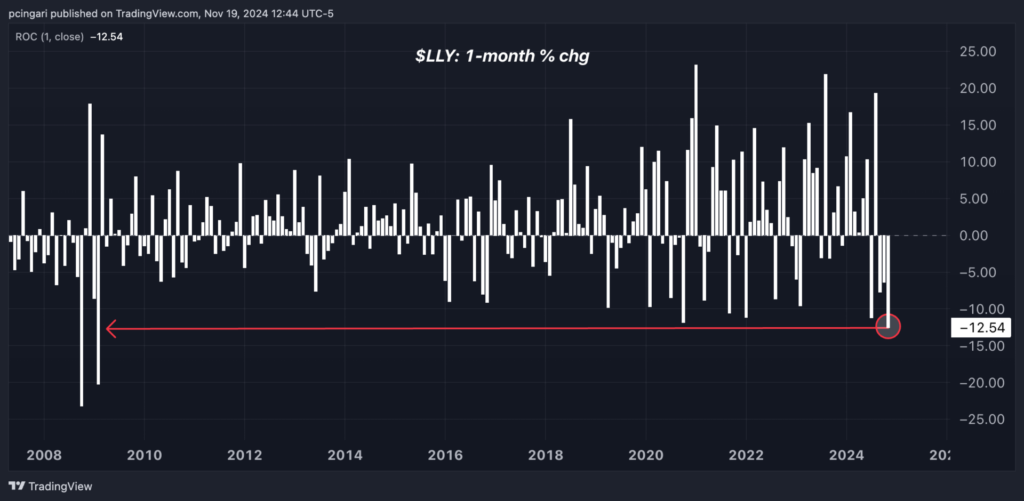Zinger Key Points
- Eli Lilly shares tumble 12.5% in November, on track for their worst monthly performance since February 2009’s 20.2% drop.
- Past sell-offs signal resilience: LLY averaged double-digit rebounds one month after rare 10%+ drops, gaining up to 24.1% in prior cases.
- China’s new tariffs just reignited the same market patterns that led to triple- and quadruple-digit wins for Matt Maley. Get Matt’s next trade alert free.
Eli Lilly & Co. LLY shares have nosedived 12.5% month-to-date through Nov. 19, putting the stock on track for its worst monthly performance since February 2009, when it tumbled 20.2%.
The pharmaceutical giant, which ranks 11th by market capitalization in the S&P 500 and holds the top spot among health care stocks, is reeling from a disappointing third-quarter earnings report and lowered guidance.
The sell-off raised doubts about the near-term prospects for Lilly's high-profile drugs Mounjaro and Zepbound, which missed revenue expectations and contributed to a storm of investor uncertainty.
For traders, the burning question now is whether Eli Lilly's pullback represents an opportunity to "buy the dip" in a high-quality, highly profitable company that maintains a position of dominance in the health care market.
Chart: LLY Shares On Track For Worst Month In Over 15 Years

The Catalyst: Weak Third-Quarter Earnings and Downgraded Guidance
Eli Lilly's third-quarter earnings report, released on Oct. 30, triggered the stock's steep decline in November.
While the company has been riding high on the success of its diabetes and obesity drugs, Mounjaro and Zepbound, both underperformed this quarter, missing revenue expectations by 14% and 26%, respectively.
Alec W. Stranahan, an analyst at Bank of America, said, "The focus this quarter was again on Mounjaro and Zepbound, which missed revenue expectations by a wide margin."
In response to the weak performance, Eli Lilly adjusted its full-year revenue guidance.
The company lowered the high end of its forecast, projecting $45.4 billion to $46 billion, down from the previous range of $45.4 billion to $46.6 billion.
Lilly management attributed the third-quarter shortfall to temporary "inventory dynamics" rather than a fundamental decline in demand, reassuring investors that this was not indicative of a broader problem with its flagship drugs.
The company also highlighted its ongoing direct-to-consumer (DTC) promotional efforts, which began in the third quarter and are expected to drive sales growth in the fourth quarter and into 2025.
Despite the negative quarter, Bank of America remains bullish on Eli Lilly despite the recent stumble. Stranahan reaffirmed his "Buy" rating on the stock with a 12-month price target of $1,100, implying a 55% upside from current levels.
Instead, Goldman Sachs took a more cautious stance, maintaining a "Neutral" rating on Eli Lilly with a 12-month price target of $890, implying a 24% upside from current levels.
Chris Shibutani, M.D., described the third quarter as a "challenging update" and flagged the $1 billion shortfall in tirzepatide revenues as a significant concern.
He expressed skepticism about whether the company can achieve its revised fourth quarter and 2025 revenue guidance.
The analyst urges caution ahead, highlighting that Eli Lilly's guidance assumes significant execution on multiple fronts, from inventory management to international expansion. "These factors need to cooperate for LLY to deliver," Shibutani said.
How Did Eli Lilly Shares React After Double-Digit Monthly Sell-offs?
Double-digit monthly selloffs have been a rarity for Eli Lilly, with only four occurrences in the past 15 years where the stock dropped more than 10% in a single month.
Interestingly, past data shows Eli Lilly has historically rebounded strongly following such declines.
Here's how the stock performed one month and three months after these major sell-offs:
| Month | LLY Monthly Loss (%) | LLY 1-Month Forward (%) | LLY 3-Month Forward (%) |
|---|---|---|---|
| October 2020 | -11.9% | +11.6% | +59.5% |
| September 2021 | -10.6% | +10.2% | +19.8% |
| January 2022 | -11.2% | +14.6% | +28.4% |
| July 2024 | -11.2% | +24.1% | +2.3% |
While history doesn't guarantee future results, the data suggests that Eli Lilly shares have demonstrated resilience following steep sell-offs, with gains ranging from 10.2% to 24.1% one month later and a solid average of positive returns over three months.
Read Now:
Photo: Shutterstock
Edge Rankings
Price Trend
© 2025 Benzinga.com. Benzinga does not provide investment advice. All rights reserved.
Trade confidently with insights and alerts from analyst ratings, free reports and breaking news that affects the stocks you care about.